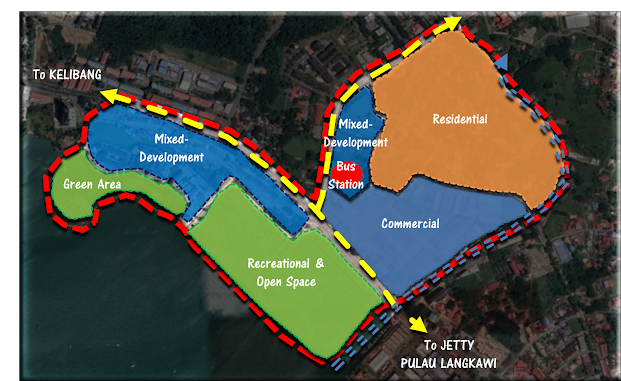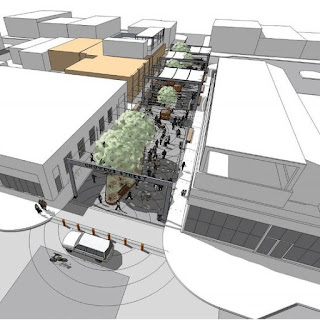Town center is the term used interchangeably
with the city center, CBD (Central Business District) or downtown, which refers to the
commercial or geographical center or core area of a town. Town centers are
traditionally associated with shopping or retail. They are also the center of
communications with major public transport hubs such as train or bus stations.
Public buildings including town halls, museums and libraries are often found in
town center. Town centres is symbolic to settlements as a whole and often
contain the best examples of architecture, main landmark buildings, statues, and
public spaces. The elements of the town center are residential, commercial,
industry, public facilities and infrastructure, and utilities.
Town center serves a wide catchment population
and it is not only an important shopping destination but also has a wider role
as a business, service, administrative, leisure, cultural, and education center.
The city’s retailing mostly anchored by departmental stores and shopping
complexes complemented by establishments related to service sectors. Despite
new initiatives and investments to implement a program aimed at to address the declining economic base of a city center and uplift problems of the innercity area,
the role of the city center is declining. The declining status is explained by
a number of key long terms trends such as relatively little modern retail floor
space available, competition from other major centre, reduced shopper satisfactions
and evidence of reduced attraction of shoppers from outside the city
center.
In the above context, the need to achieve new
development and accommodate the changing requirement is becoming critical. City
council normally places vitality and viability of the town centre among its top
policy priorities. Thus, revitalizing and regenerating the town centre was
always one of the corporate policy directions adopted in any development of a
city.
However, Development Proposal Report is prepared to explain more detail about the elements and the components that will be proposed to be developed on the study area. The important for this report, is to know the development strategy that will be developed by considering the planning aspects in a development based on the issues, data analysis, the potential and constraints in the area that need to be analysis. In addition, the development proposal report needs to illustrate the conceptual decisions, which are based on comprehensive analysis of the site conditions and their relationship to the surrounding context.
In a country with complex multiple governing structures, supports from multiple agencies are crucial in order to promote any new development concept. This needs continuous efforts and the right approaches to create interest among the various potentially responsible agencies. The most important is to identify the applied elements in a design.
The concept of Langkawi’s Heartbeat is upgrading a development baseline. This concept refers to sustainable, competitive and liveable of Pekan Kuah. To achieve these cores, some elements will propose as a support system to support and ensure that theme can be implemented.
- Capitalize on the duty-free island status to enhance the commercial sector and the town's economy.
- Provide comfortable living through maximizing affordable and quality housing.
- Enhance the green corridors and green elements within the pekan Kuah
STUDY AREA BACKGROUND
Pekan Kuah is a town for the Langkawi district. The study area is 810.00 hectares (8,100,00 km square) and under the administration of the Langkawi Municipal Council (MPLBP). It is located about 30 km from the mainland coast of northwestern Malaysia. These islands are a part of the Kedah state, which is adjacent to the Thai Border. There is no road connection all to Langkawi. Therefore, Langkawi can be reached by sea and air. Langkawi is known for its natural beauty and is a local and foreign tourist attraction. The town has about 30,000 population in 2015 and it sits on reclaimed land. Kuah was once a fishing village before becoming Langkawi’s major commercial hub. The name "Kuah" is a Malay word meaning "gravy" and is associated with an ancient legend of two battling giants who overturned a gigantic pot of curry at the spot where the town now stands.
 |
| Overall Study Area with 810 hectares (2001 acre) |
The main idea of the concept is to enhance into magnificent tourism attraction of Langkawi by incorporating elements of heartbeat in terms of strong communication systems and networks through integrated transportation strategies, efficient and environmentally friendly. At the same time, attract local people and foreign tourists to visit and at the same time contribute Langkawi in the Economic aspect.
The element would focus on the bus stop to connect all area in Pekan Kuah, governing structures supports from multiple agencies are crucial in order to promote any new development concept. With these improvements being done to the study area, in Pekan Kuah it is not only being attraction between local people and tourism, but also can improve the country’s economy.
- Lack of integrated transportation.
- Lack of parking space
- Only have one supermarket/mall in Pekan Kuah, Langkawi.
- The bicycle path and pedestrian walk are not interconnected
BENCHMARK
Benchmark is simply a standard for performance or targeted level of service delivery aspired to by the city. In order to achieve concept, a benchmark is must identify the main target in order to achieve Langkawi’s Heartbeat in Pekan Kuah, Langkawi.
|
COUNTRY |
VANCOUVER, CANADA
|
COLORADO, US |
|
ELEMENT |
|
|
DESIGN PRINCIPLES
- SUSTAINABLE
Sustainable cities, sometimes known as ecological or ‘eco’ cities, are settlements designed to have as little impact on the environment as possible. Sustainable or eco-cities can be pre-existing cities that feature management directed towards reducing the inputs of energy, water, and food and reducing the outputs of heat, water, and air pollution. Also improving the standard and availability of public transport reduces car emissions but requires a fully integrated approach to town planning to reduce the impact on businesses to keep the scheme viable.
2. INTEGRATED
Integrated is a modern planning approach close to connected with the complex nature of the cities and the necessity of creating sustainable and resilient settlements. The implementation of integrated is directly connected to the socio-economic conditions, legal frameworks, technology, and professional and educational potentials of societies, which differ for each country. It has a mixed-use development in the area.
3. CONNECTED
Connectivity refers to the directness of links and the density of connections in a transport network. A highly permeable network has many short links, numerous intersections, and minimal dead-ends. Connectivity affects the degree to which transportation networks such as streets, walking, and cycling paths, connect people to their destinations. Good connectivity provides easy access to key destinations for pedestrians. Excellent connectivity actively seeks to discourage car use by making local trips easier and more pleasant by foot than by car.
4. PUBLIC SPACE
A public space refers to an area or place that is open and accessible to all peoples, regardless of gender, race, ethnicity, age or socio-economic level. These are public gathering spaces such as plazas, squares and parks. Connecting spaces, such as sidewalks and streets, are also public spaces.
DEVELOPMENT STRATEGIES
STRATEGY 1: Revitalize of Commercial Area
Enhancing the commercial sector and implementing sustainable development.
STRATEGY 3: Revitalize Parks And Recreations
Taman Lagenda is the gateway to learn about the many historical stories attached to Langkawi. This park is one of the most interesting places in the Pekan Kuah, Langkawi area. The location is very strategic as it is located in a mixed-use development area with business, residential and surrounding areas such as Dataran Lang or Eagle Square. Open space for a recreation area that can give people get a space to have quality time with their family or partner.
This purpose will provide pedestrian pavements for public users to have a walk and it also can be a jogging track. Also can provide for skateboard users and provide a lane for cycling. This is to practice a healthy lifestyle and that encourages community living that supports of inclusively, wellness, and lifestyle with nature. This planned to ensure that all sections of the community are catered for, and that spaces are provided in locations that are safe, convenient and inviting to use and that avoid conflict, for example, between skateboarders and commercial interests or between revelers and residents.
 |
| Figure - The detailed layout of the bus terminal |
 |
| The illustration of Bus terminal |
By provision the presence of this
handcraft in the tourism area, it can promote the handicraft product that has
been using raw and indigenous materials to non-local tourists. Handicraft
products often have cultural or religious significance. It develops the skills
and creative interests of a person towards a particular craft or trade.
Proposed Stage Hall
Dataran Lang is one of Langkawi’s
best known manmade attractions, a large sculpture of an eagle poised to take
flight. A sight that greets visitors to the island via ferry, the 12 meter-tall
statue is one of the island’s most instantly recognizable monuments.
Stage hall is the public places
offer free, open forums for people to encounter art, to enjoy performances, concert
and to participate in other cultural activities. There are stage festival
events such as book festivals, food festivals, and cultural festivals that
enable people to gather and engage in social activities.
Events and festivals tourism is
one of the fastest growing forms of tourism. They are becoming increasingly
popular in rural areas as a means to revitalize local economies. Festivals and
special events play important roles in destination development, image makers,
animators of static attractions, and catalysts for other developments. This
stage provide opportunities for participation, skills development, volunteering
and social, cultural economic and environmental developments. Community events
and festivals can attract tourists and visitors at regional, national and
international level.
REFERENCES
Micheal D. Beyard, (2007). Ten Principles for Developing Succesful Town Centres
https://americas.uli.org/report/ten-principles-for-developing-successful-town-centers%E2%80%A8/
Charles H. Shaw,(2007). Forum on Urban Community Issues. Retrieved from
Asmah Che Wan,(2017). LEGAL ISSUES ON HOUSING DEVELOPMENT. Retrieved from















